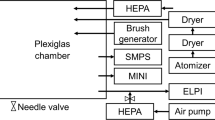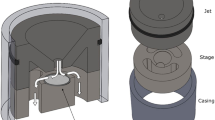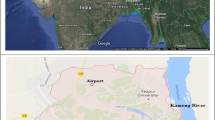Abstract
This paper discusses the combined use of electron backscatter diffraction (EBSD) and energy dispersive X-ray microanalysis (EDX) to identify unknown phases in particulate matter from different workplace aerosols. Particles of α-silicon carbide (α-SiC), manganese oxide (MnO) and α-quartz (α-SiO2) were used to test the method. Phase identification of spherical manganese oxide particles from ferromanganese production, with diameter less than 200 nm, was unambiguous, and phases of both MnO and Mn3O4 were identified in the same agglomerate. The same phases were identified by selected area electron diffraction (SAED) in transmission electron microscopy (TEM). The method was also used to identify the phases of different SiC fibres, and both β-SiC and α-SiC fibres were found. Our results clearly demonstrate that EBSD combined with EDX can be successfully applied to the characterisation of workplace aerosols.

Secondary electron image of an agglomerate of manganese oxide particles collected at a ferromanganese smelter (a). EDX spectrum of the particle highlighted by an arrow (b). Indexed patterns after dynamic background subtraction from three particles shown with numbers in a (c)








Similar content being viewed by others
References
Dingley DJ, Baba-Kishi KZ, Randle V. Atlas of backscattering Kikuchi diffraction patterns. Bristol, Eng; Philadelphia: Institute of Physics Pub; 1995.
Wisniewski W, Saager S, Böbenroth A, Rüssel C. Experimental evidence concerning the significant information depth of electron backscatter diffraction (EBSD). Ultramicroscopy. 2017;173(Supplement C):1–9. https://doi.org/10.1016/j.ultramic.2016.11.004.
Chen D, Kuo J-C. The effect of atomic mass on the physical spatial resolution in EBSD. Microsc Microanal. 2013;19(S5):4–7. https://doi.org/10.1017/S143192761301221X.
Humphreys FJ. Characterisation of fine-scale microstructures by electron backscatter diffraction (EBSD). Scripta Mater. 2004;51(8):771–6. https://doi.org/10.1016/j.scriptamat.2004.05.016.
Keller RR, Geiss RH. Transmission EBSD from 10 nm domains in a scanning electron microscope. J Microsc. 2012;245(3):245–51. https://doi.org/10.1111/j.1365-2818.2011.03566.x.
van Bremen R, Ribas Gomes D, de Jeer LTH, Ocelík V, De Hosson JTM. On the optimum resolution of transmission-electron backscattered diffraction (t-EBSD). Ultramicroscopy. 2016;160:256–64. https://doi.org/10.1016/j.ultramic.2015.10.025.
Sneddon GC, Trimby PW, Cairney JM. Transmission Kikuchi diffraction in a scanning electron microscope: a review. Mater Sci Eng R-Rep. 2016;110:1–12. https://doi.org/10.1016/j.mser.2016.10.001.
Dingley DJ, Wright SI. Determination of crystal phase from an electron backscatter diffraction pattern. J Appl Crystallogr. 2009;42(2):234–41. https://doi.org/10.1107/S0021889809001654.
Michael JR, Goehner RP. Electron backscatter diffraction: a powerful tool for phase identification in the SEM. MRS Proc 1999;589. https://doi.org/10.1557/PROC-589-39.
Small JA, Michael JR. Phase identification of individual crystalline particles by electron backscatter diffraction. J Microsc. 2001;201:59–69. https://doi.org/10.1046/j.1365-2818.2001.00788.x.
Small JA, Michael JR, Bright DS. Improving the quality of electron backscatter diffraction (EBSD) patterns from nanoparticles. J Microsc. 2002;206:170–8. https://doi.org/10.1046/j.1365-2818.2002.01015.x.
Bauer F, Hiscock M, Lang C. Advances in the analysis of gunshot residue and other trace evidence using EDS and EBSD in the SEM. Microsc Microanal. 2016;22(S3):2046–7. https://doi.org/10.1017/S1431927616011065.
Bandli BR, Gunter ME. Electron backscatter diffraction from unpolished particulate specimens: examples of particle identification and application to inhalable mineral particulate identification. Am Mineral. 2012;97(8–9):1269–73. https://doi.org/10.2138/am.2012.4155.
Bandli BR, Gunter ME. Scanning electron microscopy and transmitted electron backscatter diffraction examination of asbestos standard reference materials, amphibole particles of differing morphology, and particle phase discrimination from talc ores. Microsc Microanal. 2014;20(6):1805–16. https://doi.org/10.1017/S1431927614013415.
Donaldson K, Borm P. Particle toxicology. Boca Raton, Florida: CRC Press; 2006.
Ortner HM, Welter E. Direct speciation of solids. Handbook of elemental speciation: techniques and methodology. USA: John Wiley & Sons, Ltd; 2004. p. 505–46.
Føreland S, Bye E, Bakke B, Eduard W. Exposure to fibres, crystalline silica, silicon carbide and sulphur dioxide in the Norwegian silicon carbide industry. Ann Occup Hyg. 2008;52(5):317–36. https://doi.org/10.1093/annhyg/men029.
Gjønnes K, Skogstad A, Hetland S, Ellingsen DG, Thomassen Y, Weinbruch S. Characterisation of workplace aerosols in the manganese alloy production industry by electron microscopy. Anal Bioanal Chem. 2011;399(3):1011–20. https://doi.org/10.1007/s00216-010-4470-5.
Drown DB, Oberg SG, Sharma RP. Pulmonary clearance of soluble and insoluble forms of manganese. J Toxicol Environ Health. 1986;17(2–3):201–12.
Roels H, Meiers G, Delos M, Ortega I, Lauwerys R, Buchet JP, et al. Influence of the route of administration and the chemical form (MnCl2, MnO2) on the absorption and cerebral distribution of manganese in rats. Arch Toxicol. 1997;71(4):223–30. https://doi.org/10.1007/s002040050380.
Bertau M, Müller A, Fröhlich P, Katzberg M. Anorganische Festkörper. Industrielle Anorganische Chemie. Weinheim: Wiley-VCH Verlag GmbH & Co. KGaA; 2013. p. 457–720.
Skogstad A, Foreland S, Bye E, Eduard W. Airborne fibres in the Norwegian silicon carbide industry. Ann Occup Hyg. 2006;50(3):231–40. https://doi.org/10.1093/annhyg/mei081.
Bye E, Eduard W, Gjonnes J, Sorbroden E. Occurrence of airborne silicon-carbide fibers during industrial-production of silicon-carbide. Scand J Work Environ Health. 1985;11(2):111–5.
Dufresne A, Perrault G, Sébastien P, Adnot A, Baril M. Morphology and surface characteristics of particulates from silicon carbide industries. Am Ind Hyg Assoc J. 1987;48(8):718–29. https://doi.org/10.1080/15298668791385471.
Romundstad P, Andersen A, Haldorsen T. Cancer incidence among workers in the Norwegian silicon carbide industry. Am J Epidemiol. 2001;153(10):978–86.
Bugge MD, Kjærheim K, Føreland S, Eduard W, Kjuus H. Lung cancer incidence among Norwegian silicon carbide industry workers: associations with particulate exposure factors. Occup Environ Med. 2012;69(8):527–33.
Gunnæs AE, Olsen A, Skogstad A, Bye E. Morphology and structure of airborne β-SiC fibres produced during the industrial production of non-fibrous silicon carbide. J Mater Sci. 2005;40(22):6011–7. https://doi.org/10.1007/s10853-005-4591-y.
Bye E, Foreland S, Lundgren L, Kruse K, Ronning R. Quantitative determination of airborne respirable non-fibrous alpha-silicon carbide by x-ray powder diffractometry. Ann Occup Hyg. 2009;53(4):403–8. https://doi.org/10.1093/annhyg/mep022.
Miller A, Frey G, King G, Sunderman C. A handheld electrostatic precipitator for sampling airborne particles and nanoparticles. Aerosol Sci Technol. 2010;44(6):417–27. https://doi.org/10.1080/02786821003692063.
Hough P. Inventor Methods and means for recognizing complex patterns 1962.
Wisniewski W, Keshavarzi A, Zscheckel T, Rüssel C. EBSD-based phase identification in glass-ceramics of the Y2O3-Al2O3-SiO2 system containing α- and β-Y2Si2O7. J Alloys Compd. 2017;699(Supplement C):832–40. https://doi.org/10.1016/j.jallcom.2016.12.301.
Wisniewski W, Patschger M, Murdzheva S, Thieme C, Rüssel C. Oriented nucleation of both Ge-fresnoite and benitoite/BaGe4O9 during the surface crystallisation of glass studied by electron backscatter diffraction. Sci Rep. 2016;6:20125. https://doi.org/10.1038/srep20125.
Field DP. Recent advances in the application of orientation imaging. Ultramicroscopy. 1997;67(1):1–9. https://doi.org/10.1016/S0304-3991(96)00104-0.
Schindelin J, Arganda-Carreras I, Frise E, Kaynig V, Longair M, Pietzsch T, et al. Fiji: an open-source platform for biological-image analysis. Nat Methods. 2012;9(7):676–82. https://doi.org/10.1038/nmeth.2019.
Mitchell DRG. DiffTools: electron diffraction software tools for DigitalMicrograph (TM). Microsc Res Tech. 2008;71(8):588–93. https://doi.org/10.1002/jemt.20591.
Shaffer P. A review of the structure of silicon carbide. Acta Crystallogr Sect B: Struct Sci. 1969;25(3):477–88. https://doi.org/10.1107/S0567740869002457.
Höflich BLW, Wentzel M, Ortner HM, Weinbruch S, Skogstad A, Hetland S, et al. Chemical composition of individual aerosol particles from working areas in a nickel refinery. J Environ Monit. 2000;2(3):213–7. https://doi.org/10.1039/B001146K.
Fan J, Chu PK. General properties of bulk SiC. Silicon carbide nanostructures: fabrication, structure, and properties. Cham: Springer International Publishing; 2014. p. 7–114.
Weimer AW. Carbide, nitride and boride materials synthesis and processing: Chapman & Hall; 1997.
Post JE. Manganese oxide minerals: crystal structures and economic and environmental significance. Proc Natl Acad Sci. 1999;96(7):3447–54. https://doi.org/10.1073/pnas.96.7.3447.
Baron V, Gutzmer J, Rundlof H, Tellgren R. The influence of iron substitution on the magnetic properties of hausmannite, Mn2+(Fe,Mn)2 (3+)O4. Am Mineral. 1998;83(7–8):786–93.
Chen GS, Boothroyd CB, Humphreys CJ. Novel fabrication method for nanometer-scale silicon dots and wires. Appl Phys Lett. 1993;62(16):1949–51. https://doi.org/10.1063/1.109500.
X-w D, Takeguchi M, Tanaka M, Furuya K. Formation of crystalline Si nanodots in SiO2 films by electron irradiation. Appl Phys Lett. 2003;82(7):1108–10. https://doi.org/10.1063/1.1555691.
IARC. Monographs on the evaluation of carciogenic risks to humans: some nanomaterials and some fibres. Lyon: International Agency for Research and Cancer (WHO); 2017.
Goldstein JI, Newbury DE, Michael JR, NWM R, JHJ S, Joy DC. Scanning electron microscopy and X-ray microanalysis. New York: Springer; 2017.
Acknowledgments
The financial support by the Confederation of Norwegian Enterprise Working Environment Fund is gratefully acknowledged.
Author information
Authors and Affiliations
Corresponding author
Ethics declarations
Conflict of interest
The authors declare that they have no competing interests.
Electronic supplementary material
ESM 1
(PDF 421 kb)
Rights and permissions
About this article
Cite this article
Ervik, T.K., Benker, N., Weinbruch, S. et al. Phase identification of individual crystalline particles by combining EDX and EBSD: application to workplace aerosols. Anal Bioanal Chem 410, 2711–2721 (2018). https://doi.org/10.1007/s00216-018-0949-2
Received:
Revised:
Accepted:
Published:
Issue Date:
DOI: https://doi.org/10.1007/s00216-018-0949-2




